ADOPSI INOVASI PENGELOLAAN KEBUN KAKAO DI DESA KARUNIA, KECAMATAN PALOLO, KABUPATEN SIGI
Abstract
Cocoa is one of the largest plantation commodities in Indonesia. Indonesia is one of the largest cocoa producers in the world, ranking 6th. However, recently cocoa production in Indonesia has started to decline. The factor that inhibits cocoa production in Indonesia is the management of cocoa farms that are not in accordance with good agriculture practices (GAP). Hereditary cultivation is still often practiced by farmers in Indonesia, including cocoa farmers in Karunia Village. Managing cocoa farms in accordance with GAP cocoa cultivation will have an impact on farm productivity. The purpose of this study was to identify and measure the implementation of cocoa farm adoption and management innovations in Karunia Village. Data were collected through questionnaires, field observations, and documentation. The results showed that the adoption of innovations applied by cocoa farmers in Karunia Village includes making roraks, making vegetable pesticides, and side grafting.
Metrics
Downloads
References
[BPS] Badan Pusat Statistik. 2021. Statistik Kakao Indonesia 2021. Badan Pusat Statistika Republik Indonesia. Jakarta.
[BPS] Badan Pusat Statistik. 2022. Statistik Kakao Indonesia 2022. Badan Pusat Statistika Republik Indonesia. Jakarta.
[BPS] Badan Pusat Statistik. 2023. Statistik Kakao Indonesia 2023. Badan Pusat Statistika Republik Indonesia. Jakarta.
Adriyani FY. 2021. Desain Penyelenggaraan Penyuluhan Mendukung Program Kawasan Pertanian Sejahtera (Sapira) di Kabupaten Pringsewu Provinsi Lampung. Jurnal Risalah Kebijakan Pertanian dan Lingkungan Rumusan Kajian Strategis Bidang Pertanian dan Lingkungan 8(2): 77-86. https://doi.org/10.29244/jkebijakan.v8i2.28040
Al Ayyubi MS, Arifin HS, Kaswanto RL. 2024. Rekomendasi Strategi Pengelolaan Lanskap Publik Ruang Terbuka Hijau dan Biru di Kota Bogor. Jurnal Risalah Kebijakan Pertanian dan Lingkungan Rumusan Kajian Strategis Bidang Pertanian dan Lingkungan 11(2): 102-112. https://doi.org/10.29244/jkebijakan.v11i2.57137
Arifin HS, Munandar A, Nurhayati HSA, Kaswanto RL. 2009. Revitalisasi Praktek Agroforestri di Perdesaan (Buku Seri I: Manajemen Lanskap Perdesaan bagi Kelestarian dan Kesejahteraan Lingkungan). Kementerian Pertanian Republik Indonesia.
Aziziah SA, Setiawina ND. 2021. Analisis Pengaruh Produksi, Harga dan Nilai Tukar Terhadap Ekspor Biji Kakao Indonesia ke Belanda. Cerdika: Jurnal Ilmiah Indonesia 1: 448–455.
Efrida R, Zulkarnain F, Frapanti S, Rafindra BS. 2021. Pelatihan Pembuatan Pestisida Alami Menggunakan Bahan Utama Bawang Putih dan Daun Sirih. Proceeding Seminar Nasional Kewirausahaan 2(1): 1230–1233.
Hapsari OA. 2023. Kakao Indonesia: Produksi, Tantangan dan Peluang. Balai Informasi Standar Instrumen Pertanian. https://bisip.bsip.pertanian.go.id/.
Heriaty A, Triasni ARA. 2021. Adopsi Penerapan Pengelolaan Tanaman Terpadu (PTT) Padi Sawah di Kelompok Tani Bolie Kelurahan Salokaraja Kecamatan Lalabata Kabupaten Soppeng. Jurnal Ilmiah Agrotani 3(2): 235-240. https://doi.org/10.54339/agrotani.v3i2.244.
Hernawati H. 2021. Analisis Efisiensi Teknis Usahatani Padi Lahan Irigasi di Kabupaten Lombok Barat. Risalah Kebijakan Pertanian dan Lingkungan Rumusan Kajian Strategis Bidang Pertanian dan Lingkungan 8(2): 87-91. https://doi.org/10.29244/jkebijakan.v8i2.28037.
Hubeis M, Widyastuti H, Wijaya HD. 2015. Prospek Cerah Produksi Sayuran Organik Bernilai Tambah Tinggi Berbasis Petani. Risalah Kebijakan Pertanian dan Lingkungan Rumusan Kajian Strategis Bidang Pertanian dan Lingkungan 1(2): 110-115. https://journal.ipb.ac.id/index.php/jkebijakan/article/view/10302.
Kaswanto RL. 2009. Alat Metode dan Pendekatan Analisis Lanskap Agroforestri. In Arifin HS et al (Eds). Analisis Lanskap Agroforestri: Konsep, Metode, dan Pengelolaan Agroforestri Skala Lanskap dengan Studi Kasus Indonesia, Filipina, Laos, Thailand, dan Vietnam. Institut Pertanian Bogor (IPB) Press, Bogor.
Mowidu I, Dewi ES. 2022. Rekayasa Lingkungan Perakaran Melalui Sistem Rorak untuk Meningkatkan Serapan Hara Pada Tanaman Kakao. Agropet 19(1): 9–15.
Nurwardani GS, Setiawan I, Noor TI. 2023. The Analysis of Rice Commodity Procurement Sustainability in Pasar Induk Cikurubuk, Tasikmalaya, West Java. Jurnal Agrinika: Jurnal Agroteknologi dan Agribisnis 7(1): 44–56. https://doi.org/10.30737/agrinika.v7i1.2318.
Pratiwi, Salim G. 2013. Aplikasi Teknik Konservasi Tanah Dengan Sistem Rorak Pada Gmelina (Gmelina arborea Roxb.). di KHDTK Carita, Banten. Jurnal Penelitian Hutan dan Konservasi Alam 10(3): 273–282. https://doi.org/10.20886/jphka.2013.10.3.273-282.
Rejekiningrum P, Kartiwa B. 2022. Kontribusi Pembangunan Infrastruktur Panen Air terhadap Peningkatan Pendapatan dan Kesejahteraan Petani. Risalah Kebijakan Pertanian dan Lingkungan Rumusan Kajian Strategis Bidang Pertanian dan Lingkungan 9(1): 37-51. https://doi.org/10.29244/jkebijakan.v9i1.28073.
Rogers EM. 2003. Diffusion of Innovations. (5thed). Free Press. New York.
Rohma MF, Wikanta W. 2021. Pengaruh Ekstrak Daun Pepaya (Carica papaya) sebagai Pestisida Alami terhadap Aktivitas Kecoa (Periplaneta americana) dan Pembelajarannya Pada Masyarakat. Jurnal Pedago Biologi 9(1): 27–33.
Saputro WA, Fidayani Y. 2020. Faktor-faktor yang Mempengaruhi Produksi Kakao Desa Nglanggeran Kecamatan Patuk Kabupaten Gunungkidul. Vigor: Pertanian Jurnal Tropika Ilmu dan Subtropika (Journal of Tropical And Subtropical Agricultural Sciences) 5(1): 24–30.
Saputro WA, Sariningsih W. 2020. Kontribusi Pendapatan Usahatani Terhadap Kakao Pendapatan Rumah Tangga Petani di Taman Teknologi Pertanian Nglanggeran Kecamatan Pathuk Kabupaten Gunungkidul. Sepa: Jurnal Sosial Ekonomi Pertanian Dan Agribisnis 16(2): 208–217.
Setiawan J, Sjaf S, Aulia R, Parahita AA, Rohadi PP. 2024. Plant Biodiversity of Mixed Garden in Lariang Mamasa Watershed, West Sulawesi. IOP Conference Series: Earth and Environmental Science 1359(1): 012091. IOP Publishing. https://doi.org/10.1088/1755-1315/1359/1/012091
Siregar THS, Riyadi S, Nuraeni L. 2021. Panduan Praktis Budidaya Kakao. Penebar Swadaya. Jakarta.
Sudiarta IM, Prabowo A, Gubali S, Buheli A, Sirajuddin Z. 2022. Pengaruh Kombinasi Bioslurry dan Air Kotoran Lele terhadap Tanaman Jagung (Zea mays L.). ZIRAA’AH 47(3): 330–341. https://doi.org/http://dx.doi.org/10.31602/zmip.v47i3.8032.
Wiyono S, Widodo, Triwidodo H. 2015. Mengelola Ledakan Hama dan Penyakit Padi Sawah pada Agroekosistem yang Fragil dengan Pengendalian Hama Terpadu Biointensif. Risalah Kebijakan Pertanian dan Lingkungan Rumusan Kajian Strategis Bidang Pertanian dan Lingkungan 1(2): 116-120.
Zain FA, Nurrochmat DR. 2021. Analisis Finansial dan Nilai Tambah Usaha Agroforestri Kopi pada Program CSR PT Indonesia Power Up Mrica Kabupaten Banjarnegara. Jurnal Risalah Kebijakan Pertanian dan Lingkungan Rumusan Kajian Strategis Bidang Pertanian dan Lingkungan 8(3): 109-120. https://doi.org/10.29244/jkebijakan.v8i3.33482
Copyright (c) 2024 RISALAH KEBIJAKAN PERTANIAN DAN LINGKUNGAN: Rumusan Kajian Strategis Bidang Pertanian dan Lingkungan

This work is licensed under a Creative Commons Attribution 4.0 International License.
PUBLICATION ETHICS
Jurnal Risalah Kebijakan Pembangunan Pertanian dan Lingkungan (JRKPL) is a peer-reviewed journal publishing original research to develop a coherent and respected network of landscape architecture knowledge. JRKPL committed to upholding the highest standards of publication ethics that clarifies ethical behavior of all parties involved in publishing a scientific article in JRKPL.
As publisher of JRKPL, PSP3-LPPM IPB and PERHEPI takes its duties of guardianship all stages of publishing process and we recognize our ethical and other responsibilities.
Duties of Authors
An author should not publish manuscripts describing essentially the same research in more than one journal or primary publication. Submitting the same manuscript to more than one journal is unacceptable and constitutes unethical publishing behavior. In general, an author should not submit for consideration in another journal a previously published paper.
Authorship should be limited to those who have made a significant contribution to the manuscript and should be listed as co-authors. Where there are others who have participated in certain substantive aspects of the research project, they should be acknowledged as contributors. The corresponding author should ensure that all co-authors have seen and approved the final version of the paper and have agreed to its submission for publication.
The authors should ensure that they have written entirely original works, and if the authors have used the work and/or words of others, that this has been appropriately cited or quoted. Plagiarism are include passing off another paper as the author own paper, copying or paraphrasing substantial parts of another paper (without attribution) and claiming results from research conducted by others. Plagiarism constitutes unethical publishing behavior and is unacceptable. Plagiarism detected works will be banned for further publication procedure.
The authors acknowledge that they have disclosed all and any actual or potential conflicts of interest with their work or partial benefits associated with it. All sources of financial support for the project should be disclosed. Potential conflicts of interest should be disclosed at the earliest stage possible.
Duties of the Editorial Board
Review Process
JRKPL is committed to objective and fair double-blind peer-review to prevent any actual or potential conflict of interests between the editorial and review personnel and the reviewed material. JRKPL chooses reviewers based on their expertise (whose most closely matches the topic of the paper). At least 2 reviewers are invited to evaluate a manuscript. In cases of controversy or disagreement regarding the merits of the work, an additional review will be solicited. The JRKPL editor mediates all interaction between authors and reviewers, and the review results owned by JRKPL.
Publication Decisions
The editor of a peer-reviewed JRKPL is responsible for deciding which of the articles submitted to the journal should be published. The validation of the work in question and its importance to researchers and readers must always drive such decisions. The final decision on article acceptance based on reviewer's opinions, suggestions, and comments. The editor may confer with other editors or reviewers in making this decision.
Fair Play
JRKPL evaluates manuscripts only based on the intellectual content. No race, gender, sexual orientation, religious belief, ethnic origin, citizenship, or political philosophies of the authors are considered in the evaluation process.
Confidentiality
JRKPL assure the confidentially of the manuscripts, actors, and other related information on the publishing process. Only corresponding author, reviewers, potential reviewers, other editorial advisers, and the publisher are allows for the information.
Disclosure
Unpublished materials disclosed in a submitted manuscript must not be used in an editor's own research without the express written consent of the author. Privileged information or ideas obtained through peer review must be kept confidential and not used for personal advantage.
Duties of reviewers
(1) Objectivity: Reviewer should provide written and unbiased feedback to the authors, personal criticism of the author is inappropriate. Reviewer comments should be clearly with supporting arguments indicating whether the writing is concise and relevant
(2) Expertise: Reviewer who feels unqualified to review the research reported in a manuscript or knows that its prompt review will be impossible should notify the editor and excuse himself from the review process.
(3) Acknowledgement of sources: Reviewer suggest relevant published work that has not been cited by the authors to improve the quality of the manuscript,
(4) Confidentiality: Reviewer should maintain the confidentiality of the review process. Privileged information or ideas obtained through peer review must be kept confidential and not used for personal advantage.
(5) Disclosure and conflict of interest: Unpublished materials disclosed in a submitted manuscript must not be used in a reviewer own research without the express written consent of the author. Reviewers should not consider manuscripts in which they have conflicts of interest resulting from competitive, collaborative, or other relationships or connections with any of the authors, companies, or institutions connected to the papers.






















